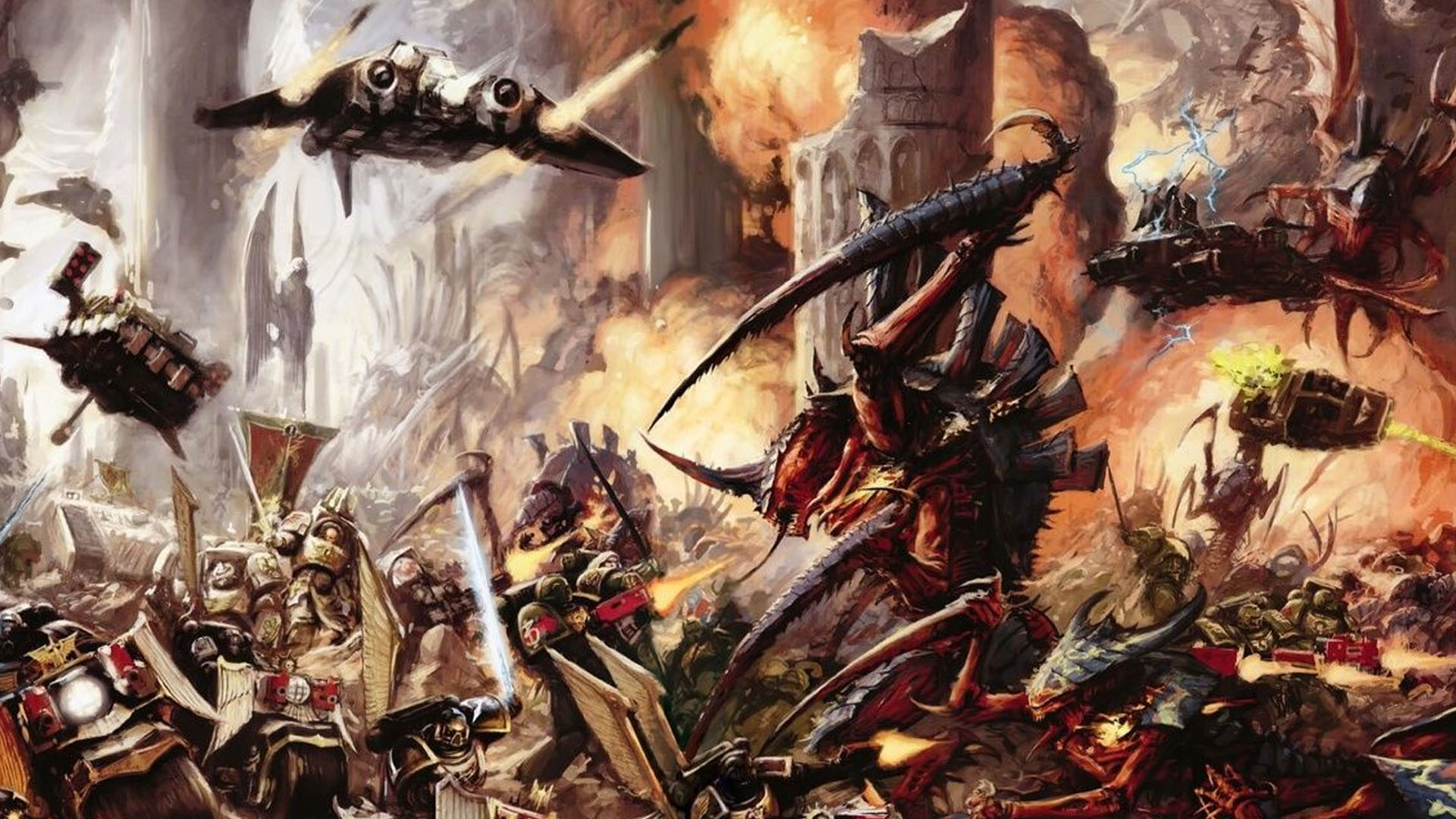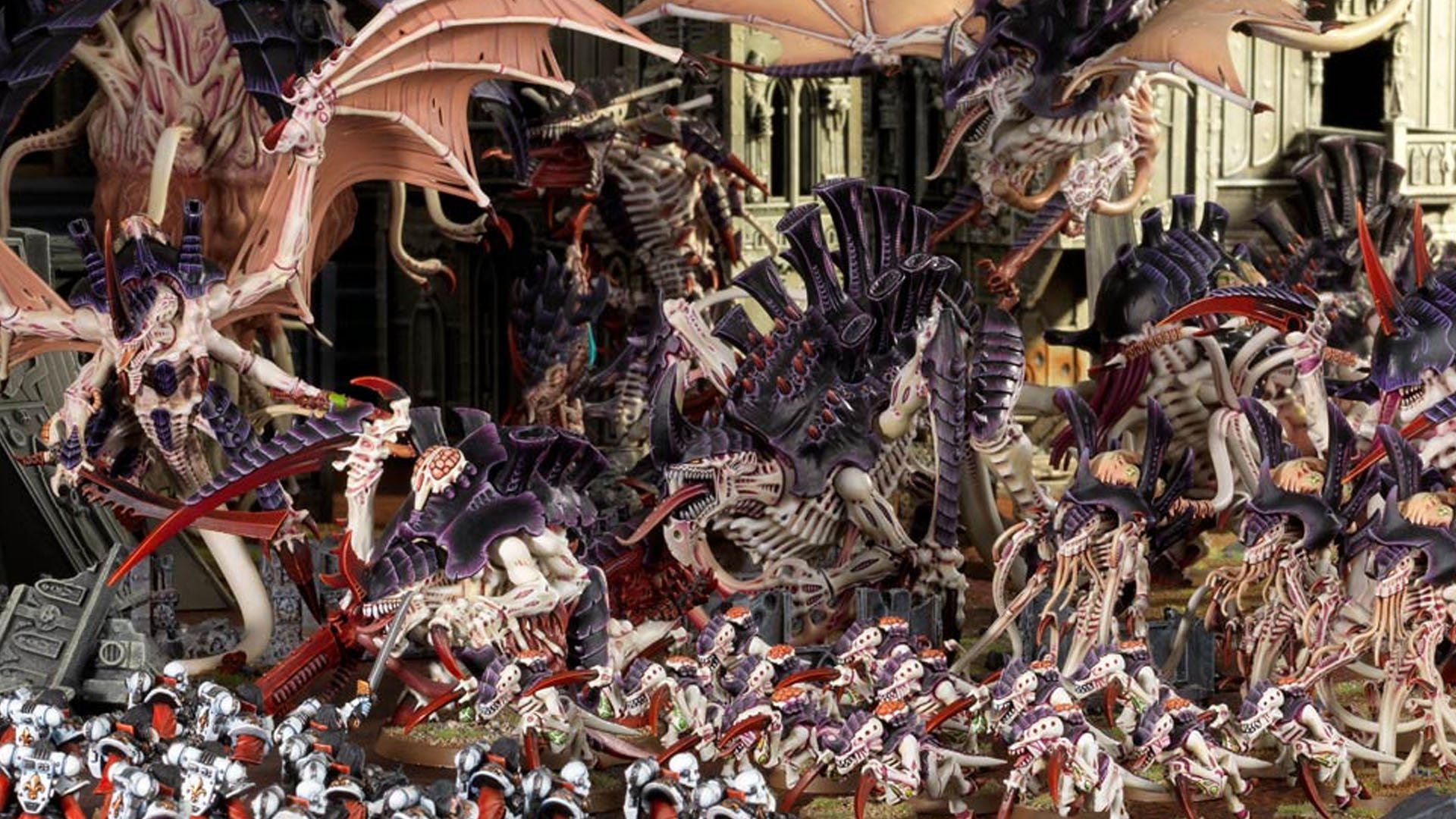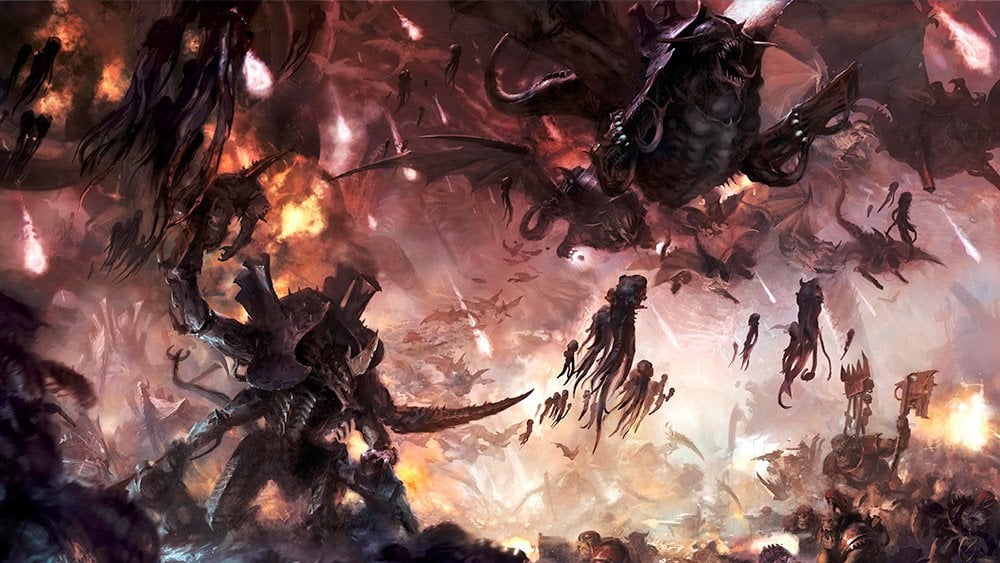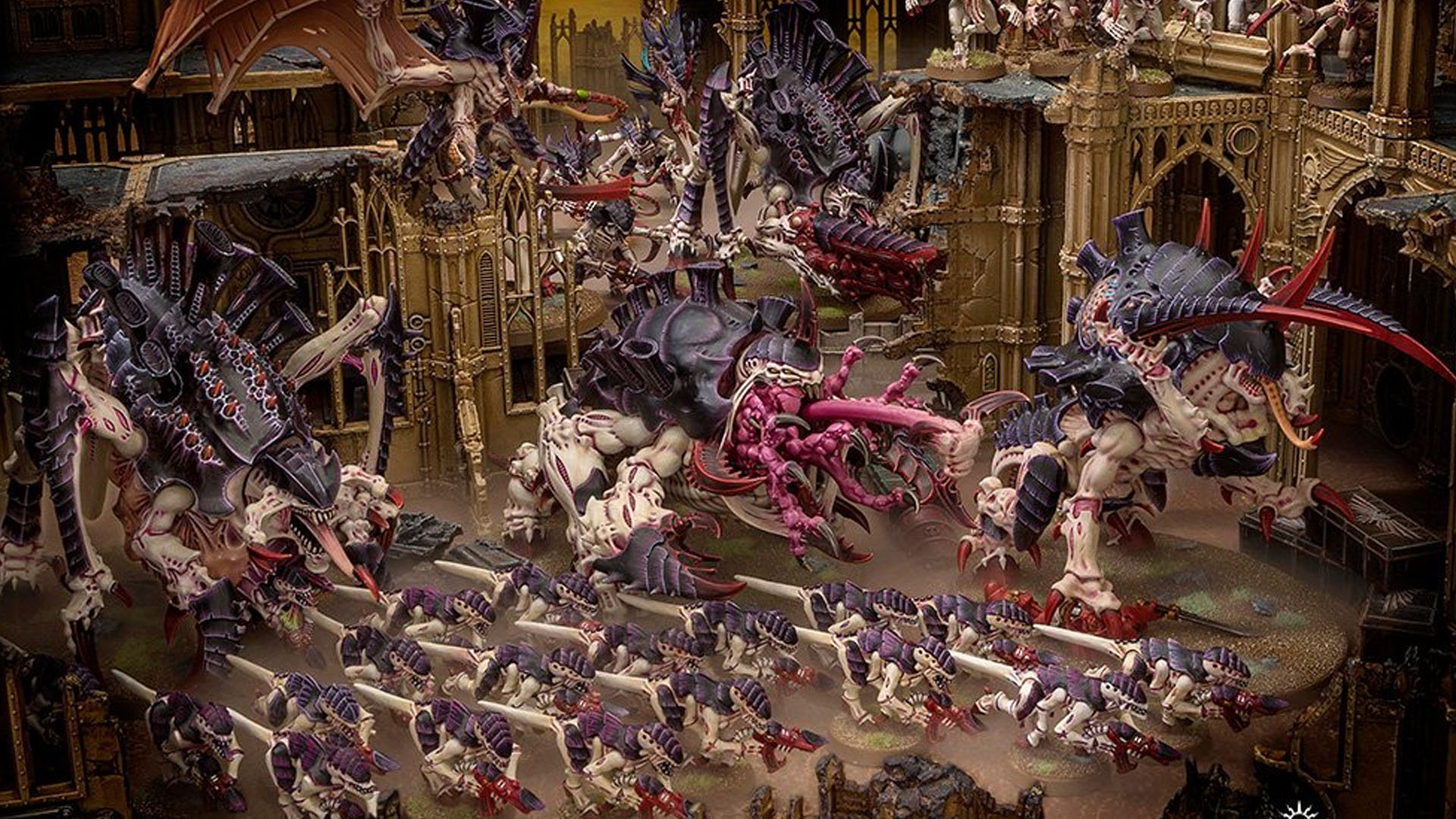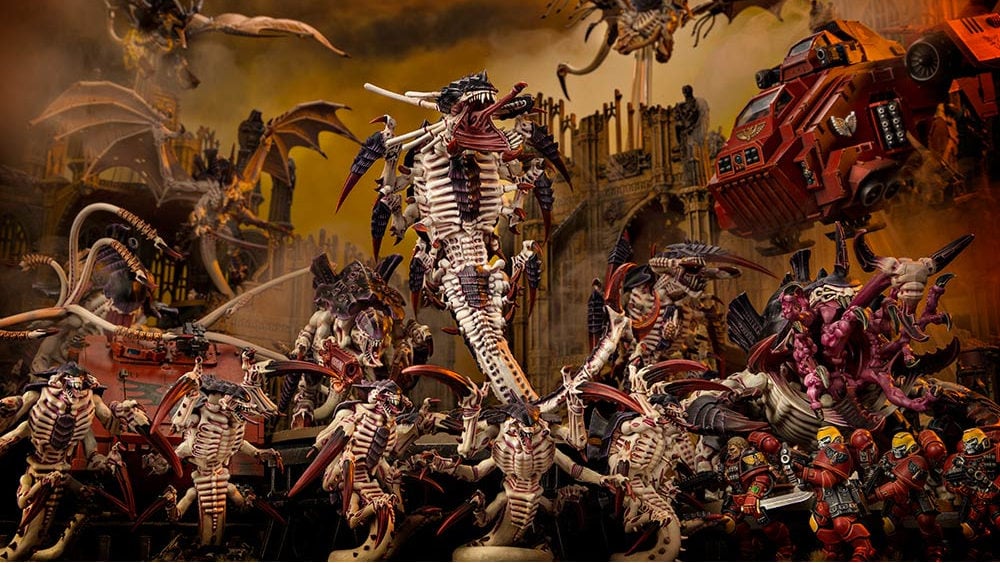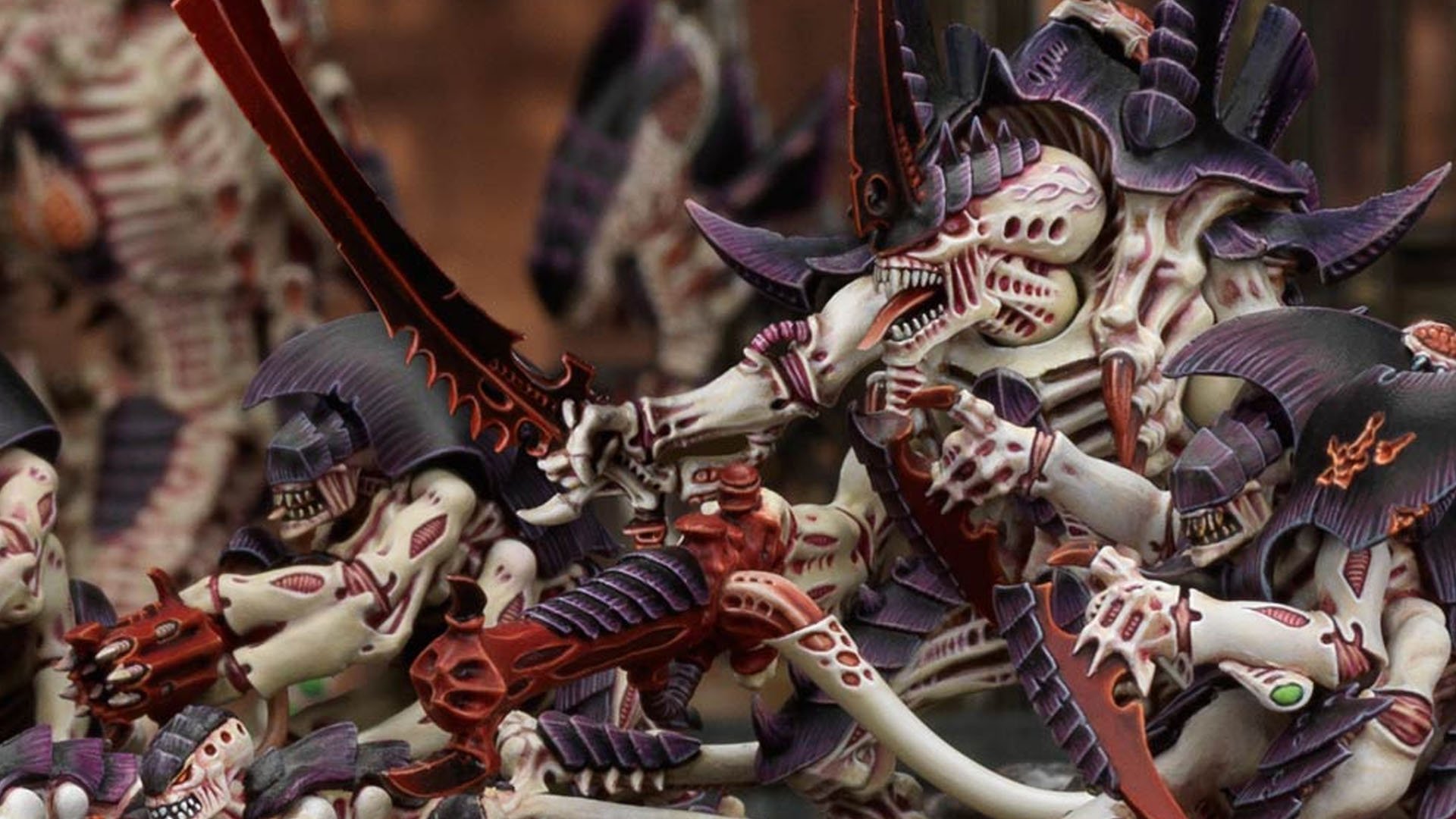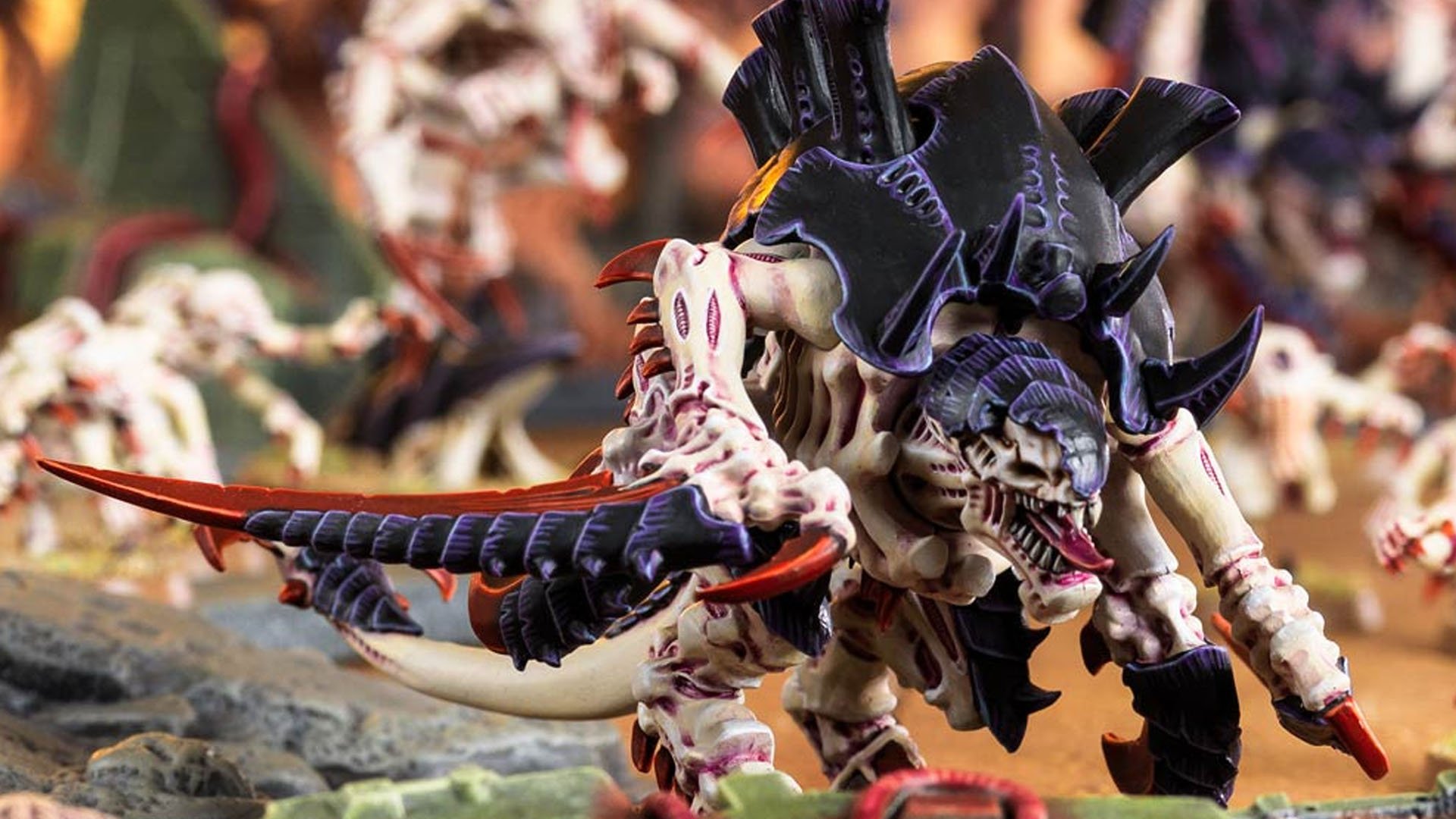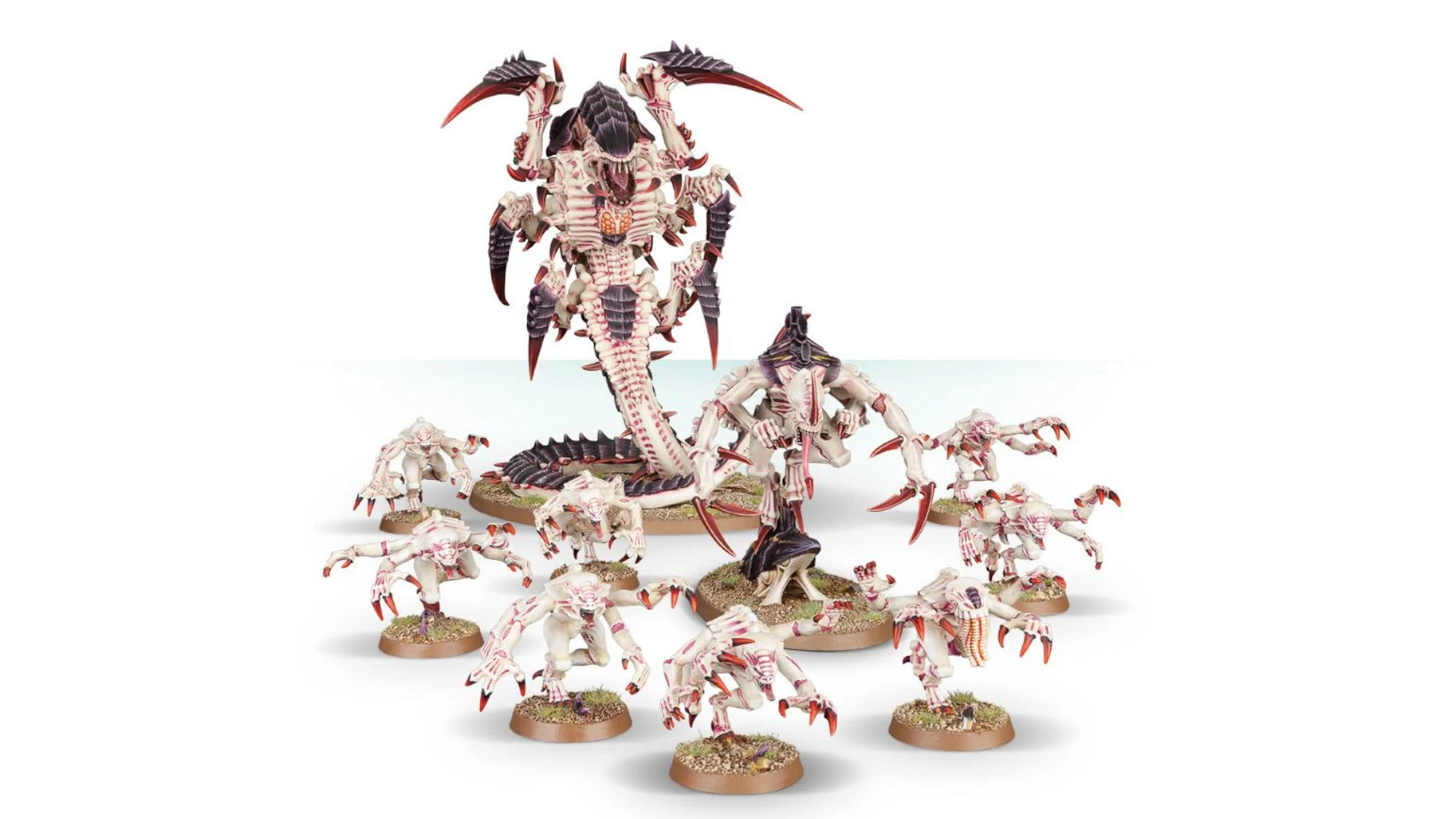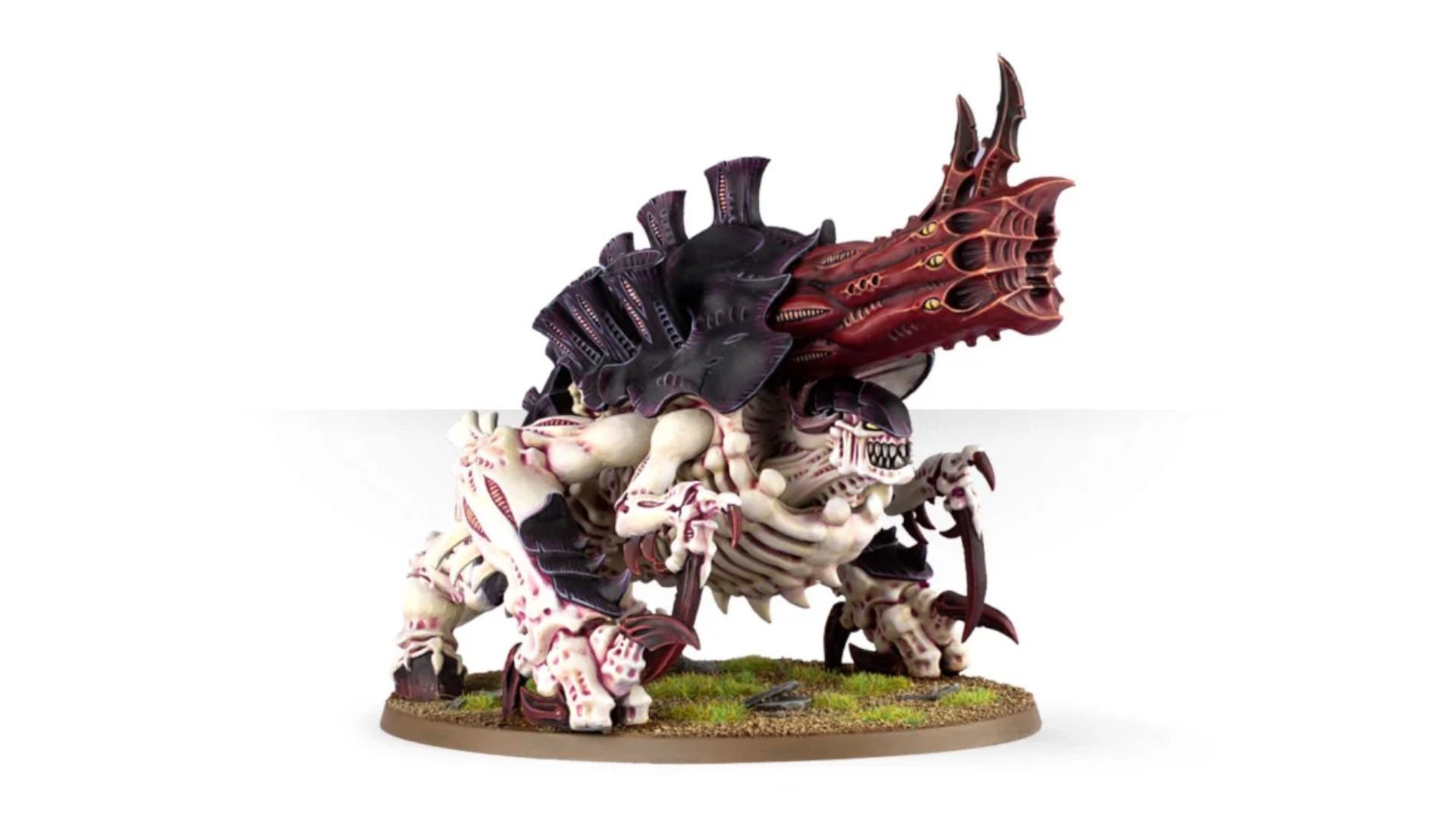Always hungry, always invading, and always on the move. Warhammer 40k Tyranids are an existential threat to the entire galaxy, appearing out of nowhere to inflict total death on any living creature that faces them. There’s no bargaining with the Tyranids, there’s no diplomacy, just the eternal need to expand and devour. If you’re on a planet in the Imperium of Man and you hear the Xenosalarms ringing, we recommend making peace with the Emperor – there’s little else you can do.
Warhammer 40k Tyranids are one of the oldest factions in, with roots going back to the very first edition of the game. Though they were redesigned a few times in their early appearances, since 1990 they have had a fairly consistent look and backstory. Now, they stand as one of the pillars of Warhammer 40k, being one of the most popular armies due to their unique design, playstyle, and wealth of models to use in battle.
If you’ve ever fancied yourself a brooding telepathic mind behind a never-ending army of mindless warriors, or are a fan of the Alien film franchise and want to explore an army with a similar visual style, then the Tyranids may be the 40k army for you.
Let’s break down the Warhammer 40k Tyranids and learn how they tick:
Tyranids Lore
Even though the Tyranids are one of the oldest armies in Warhammer 40k, there is relatively little information about them. The reason for this is simple; if you encounter them, you either kill them or you die. There’s no opportunity to ask questions afterwards.
Humanity first encountered the Tyranids in 745.M41, although rumours persist of previous contacts being covered up, which is in-keeping with all we know of the Imperium of Man. When more was learned about them, it became clear that the Tyranids are not of our galaxy. Instead, they have descended upon the Milky Way from the void between galaxies.
Despite not being involved in the eternal war between living creatures and Chaos, the reason the Tyranids came to our galaxy lies, like many things, in the Horus Heresy. During the rebellion, the Pharos device was found -a beacon that allowed Ultramarine ships, among others, to sail the tides of the immaterium during a period of intense warp storms.
In one battle, the Pharos device became overloaded, sending a psychic signal out in all directions. This drew the attention of the Tyranids like a lighthouse attracts the attention of passing ships, their forces sailing out in the cold dark, causing them to turn their terrible eyes onto us.
It took a long time for the Tyranids to bring their warriors to our galaxy, and over ten thousand years of travel passed before they even breached the edges of the Milky Way. Now, however, they are here, and they’re not likely to leave.
Their forces are innumerable and diverse, but the most commonly seen creature is the Tyranid Warrior -fierce monsters with elongated skulls that bring fear and death wherever they go. The Tyranid Warrior exemplifies everything that makes this faction a threat: they’re adaptable, durable, and even show signs of intelligence, wielding weapons in their four arms.
No one knows what the Tyranids want in our galaxy, but we do know they are all telepathically connected, linking together to form a colossal hive mind that is terrifyingly alien. This telepathy is what first drew them to us, but now they are drawn by another flame: the light of the Astronomicon. Their movements are forever spiralling towards Terra and the Golden Throne of the Emperor of Man, though for what purpose no one can ever know.
Tyranid Hive Fleets
The Tyranids did not arrive all at once but split their forces into several different Tyranid Hive Fleets. Each of these humongous, biomechanical armadas were given names by humanity, and many have been encountered or destroyed.
But much like their origins and motivations, little is known of how many Hive Fleets are currently descending on the galaxy. What’s more, no one knows if these Hive Fleets represent the majority of the Tyranid forces or just a tiny scouting party.
Each Tyranid Hive Fleet has its own specialisation, making them entirely unique despite some shared features. Here are some of the most famous Hive Fleets known to us:
- Behemoth – Hive Fleet Behemoth was the first to make contact with humanity (that we know of, at least), and as a result has become the most infamous of them all. Striking deep into Ultramarine space, it was eventually defeated at the Battle for Macragge, with its supremely aggressive Tyranid Warriors proving no match for Ultramarine forces at the end.
- Kraken – Kraken was the second Hive Fleet that humanity encountered, ultimately being responsible for the Second Tyrannic War. Kraken Tyranids are known for their speed, moving faster than believed possible to strike behind enemy lines.
- Gorgon – Defeated by the Tau and the Astra Militarum, the Tyranids of Hive Fleet Gorgon specialised in adaptation, twisting their forms to the requirements of any situation. While many Hive Fleets rely on a few stalwart bioforms, Gorgon fielded variations never seen before, and never seen again following its destruction.
- Jormungandr – This Tyranid Hive Fleet was smaller than most but became a juggernaut through smart, stealthy methods. Its Tyranids would hurl their spores at unsuspecting planets; their submerged Norn-Queens breeding an army out of the ground itself, burrowing and forming networks under the feet of their enemies before rising to feast. This Hive Fleet has since been largely destroyed, but given Tryanids’ nature, it’s impossible to ever be certain of their destruction.
- Leviathan – Leviathan is the largest Tyranid Hive Fleet to ever assault the galaxy. Leviathan’s unique ability relates to the strength of its synaptic network that semi-telepathically binds its Tyranids. It allows them to fight long past most normal Tyranids would be laid low, always serving the hive mind even when mortally wounded.
- Hydra – Hive Fleet Hydra was encountered not by humanity but by Dark Eldar. Finding them still slumbering before their invasion of the galaxy, the Drukhari’s curiosity saw them attempt to capture the Tyranids. Unfortunately for them, and us, Hive Fleet Hydra regenerates faster than any other Hive Fleet, seeing the fleet awaken and fall upon the unsuspecting Eldar with horrifying alacrity.
- Kronos – This Hive Fleet is unique even among Tyranids, as it seems to specialise in fighting the forces of Chaos. One of the ways it achieves this is to stand back, unlike many other Tyranid forces, preferring to shoot from a distance rather than scuttle into the melee and risk the taint of the Ruinous Powers.
Tyranid Paint Schemes
One of the benefits of collecting a Tyranids army is that they have a look and feel completely different to anything else on the battlefield. You’ll find no metal armour here, no sci-fi guns or tanks (unless you count the related Genestealer Cults armies, but that’s a different matter for a different day). Instead, the Tyranids consist of flesh and bone, with many Tyranids paint schemes highlighting their unique xenology.
Official Games Workshop Tyranids paint schemes are an excellent place to start when looking to paint your own Tyranids collection. For example, Hive Fleet Behemoth uses rich dark purple tones on the bone armour with pale flesh underneath. This allows you to highlight areas such as eyes, tongues, teeth, and weapons, drawing attention to their wickedly sharp blades or bio-engineered guns.
If you want to create your own paint scheme then the sky’s the limit for your creativity. Tyranid models are as adaptable as can be, are and can look stunning even when painted by a novice.
Nooks and crannies in their alien flesh lead naturally to using shade paints, letting the liquid pool in darker areas to help give depth to the model. Similarly, their bone carapaces work well with dry brushing techniques, helping you make the model’s edges pop while maintaining their unique organic feel.
We recommend choosing colours that contrast yet complement each other to define your own Tyranids paint scheme. Common paint schemes often use rich reds on the flesh with dark blues on the carapaces, black and grey flesh with vivid orange armour, or even radioactive greens on the bones to contrast with darker flesh colours. A place you can always look for inspiration is nature; insects, in particular, provide particularly fertile ground for colour combinations.
Tyranids Codex
The Tyranids codex hit shelves in April 2022, bringing the alien armies to the forefront of ninth edition. In addition to updated Tyranid datasheets and Tyranid lore, the codex includes plenty of customisation options in the form of Hive Fleet Adaptations and Synaptic Imperatives.
Plenty of Tyranid goodies (or nasties, depending on what side you’re on) return from eight edition with a few tweaks here and there. Expect to see updated Death Throes and Living Artillery.
There were already some Tyranid-specific rules in ninth edition thanks to War Zone Octarius – Book 1: Rising Tide. This narrative book contains many rules specific to Tyranids, bringing new features to the faction and providing valuable tactics that have been sorely missed during the 9th edition of the game. Before the codex’s release, it was a Tyranid must-have – now some of its rules, like the Synaptic Link abilities, can be found in the fresh codex.
Tyranid Tactics
On the face of it, Tyranid tactics may seem simple. You field a tonne of models, you charge them at the opponent, and you kill until you can kill no more. However, with the advent of recent rules changes and the 9th Edition focus on scoring points rather than outright murder, there are many Tyranids tactics to take notice of that can make the difference on the battlefield.
The first rule to pay attention to, which will help define the entire strategy for your army, is your choice of Hive Fleet. This will not only help determine how you’ll approach the battle but also the Tyranid models and units to take with you. If you favour a fast-moving army that swiftly advances up the board then Hive Fleet Kraken may be the fleet for you. Similarly, if a strong gunline makes all the difference then we’d recommend looking at Hive Fleet Kronos.
With Hive Fleets being so specialised, unlike many factions, it may be an idea to field two different Hive Fleets at once, though this will cost CP to do so. This will allow you to take advantage of the adaptations of both, such as allowing you to have a hard-hitting Hive Fleet Hydra force for close-combat encounters, alongside Hive Fleet Jormungandr units to take objectives and stay alive through their cover bonuses.
When it comes to fielding your army, you’ll want to always remember your Synaptic Links. These are unique to Tyranids armies and allow larger models to project an aura that gives bonuses to nearby units. The downside, however, is that if those units move outside of the Synapse area they will lose these benefits, making them easier to kill, less useful, or even detracting from your battle plan. While your units are in Synapse, they also ignore Morale rolls, making this essential if they’re under attack.
Warhammer 40k Tyranid Stratagems can often give you the edge in a battle, with many being an absolute pleasure to deploy due to their uniquely-Tyranid flavour. Some of the best Tyranid Stratagems include Digestive Denial, which lets you remove a of terrain’s effects at the start of the battle, Voracious Appetite, which allows you to re-roll a unit’s Wound rolls, and Scorch Bugs, which sees your Fleshborers gain +1 to Wound.
You might not think that the Tyranids are a natural fit for psychic abilities, but their telepathic connections make them one of the strongest factions when it comes to psychic battles. For example, their ability to use Zoanthropes to cast Smite multiple times per round makes them able to throw out overwhelming mortal wounds, something only the Grey Knights can compete with. Tyranid armies are also brilliant at avoiding Perils of the Warp, as Neurothropes have an aura whereby 1s rolled in the psychic phase can be re-rolled.
In addition to this, almost all Tyranid psychic powers are useful, and often cheaper to cast than their counterparts in other factions. If you like to see your opponent’s face fall, then the psychic phase may be one of exceptional glee for you.
How to start collecting Tyranids
If your interest is piqued by the ravening horde of Tyranids and you want to start your own collection, here’s the best way to get competitive – fast.
Firstly we would definitely recommend picking up the Start Collecting! Tyranids box set. This includes eight Genestealers with rending claws, a Broodlord, and a Tyranid Trygon that can also be assembled as a Mawloc.
From there we would recommend filling out your army with Tyranid Warriors, who will act as your main troops for most battles, a Neurothrope for enhanced psychic powers, and a swarm of Zoanthropes. This will give you a colossal amount of damage during the psychic phase, with Smite being almost casually thrown out.
For ranged support, we would recommend Termagants armed with Fleshborers, Hive Guards, and an Exocrine. The Termagants will soak up damage and allow your more valuable units to get into place, while your Exocrine excels at taking out enemy elites.
Also, the Exocrine is a stunning Tyranid model, which is always a plus when building an army. Hive Guards, meanwhile, are one of the most brutal units when it comes to pumping out threatening amounts of damage, so if you can only invest in one of these three, they’d be our pick.
If you want to make your melee line a little beefier, you can’t go wrong with Hive Tyrants. If your focus is going to be close combat then we would also recommend building out your Genestealers to be a larger force, as they work together excellently and can help keep your tougher models alive by distracting your opponent. You also can’t go wrong with some Tyranid Raveners, a variation of the Tyranid Warriors which will do heavy damage when rushing into your opponent’s line.
Now you should be ready to face down your enemies with hands full of bio-forged weapons and a mind full of telepathic buzz. As always, we recommend experimentation, from both army setup to paint schemes, as you’ll soon find what works for you. But you should now have a solid grounding on which to build a colossal Tyranid juggernaut.
Source: Wargamer



